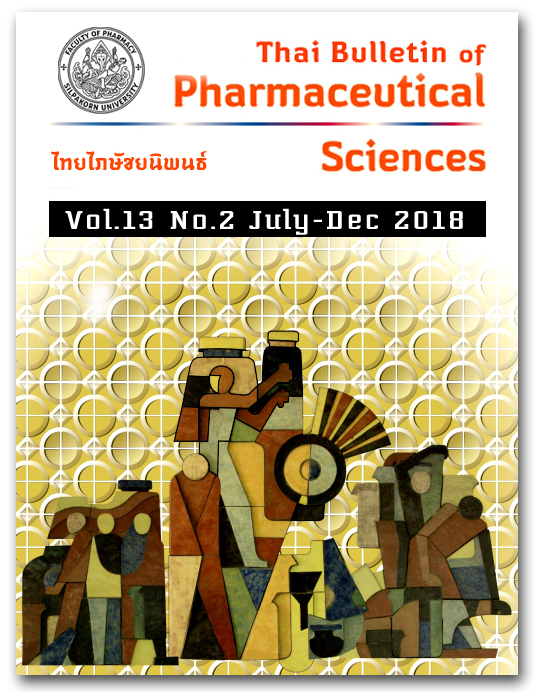EVALUATION OF MEDICATION USE IN PATIENTS WITH CHRONIC HEART FAILURE AT HUA-HIN HOSPITAL
DOI:
https://doi.org/10.69598/tbps.13.2.163-171Keywords:
chronic heart failure, evaluation, guideline recommended treatmentAbstract
Chronic heart failure has become one of the major health problems in Thailand, due to high mortality rate and excessive medical expenditure. Thus, treatment which is based on guideline recommendations is important. The present study was a retrospective observational study aimed to evaluate medication treatment in chronic heart failure patients with left ventricular ejection fraction less than 40% compared with the guideline recommendations at Hua-Hin Hospital. The data was analyzed by descriptive statistics and chi-square test. Fifty- one chronic heart failure patients with left ventricular ejection fraction less than 40% were included in the study. The results showed that the three most-prescribed medications were loop diuretics (92.2%), beta blockers (56.8%) and ACEIs or ARBs (52.9%), respectively. Moreover, 29.4% of patients used a combination of ACEIs or ARBs and beta blockers. As well, 17.6% of patients were treated with ACEIs or ARBs combined with beta blockers and mineralocorticoid antagonist, which was consistent with guidelines for recommended treatments. In addition, a re-admission rate was lower in the group taking guideline-recommended treatments.
References
2. Loehr LR, Rosamond WD, Chang PP, Folsom AR, Chambless LE. Heart failure incidence and survival (from the Atherosclerosis Risk in Communities study). Am J Cardiol. 2008;101:1016–22.
3. Roger VL, Weston SA, Redfield MM, Hellermann-Homan JP, Killian J, Yawn BP, et al. Trends in heart failure incidence and survival in a community-based population. JAMA. 2004;292(3):344-50.
4. Moleerergpoom W, Hengrussamee K, Piyayotai D, Jintapakorn W, Sukhum P, Kunjara-Na-Ayudhya R, et al. Predictors of in-hospital mortality in acute decompensated heart failure (Thai ADHERE). J Med Assoc Thai. 2013;96(2):157-64.
5. Allen LA, Fonarow GC, Liang L, Schulte PJ, Masoudi FA, Rumsfeld JS, et al. Medication initiation burden required to comply with heart failure guideline recommendations and hospital quality measures. Circulation. 2015;132(14):1347-53.
6. Yoo B, Oh J, Hong B, Sjom D, Bae J, Yang D, et al. Survey of guideline adherence for treatment of systolic heart failure in real world (SUGAR): A multicenter, retrospective, observational study. PLOS ONE. 2014;9(1):1-7.
7. Poelzla G, Altenbergerb J, Pacherc R, Ebnerd C, Wiesere M, Winterf A, et al. Dose matters! optimization of guideline adherence is associated with lower mortality in stable patients with chronic heart failure. Int J Cardiol. 2014;175(1):83-9.
8. Cowie MR, Mosterd A, Wood DA, Poole-Wilson PA, Sutton GC, Grobbee DE. The epidemiology of heart failure. Eur Heart J. 1997;18:208–25.
9. Adams Jr KF, Fonarow GC, Emerman CL, LeJemtel TH, Costanzo MR, Abraham WT, Berkowitz RL, Galvao M, Horton DP. ADHERE Scientific Advisory Committee and Investigators. Characteristics and outcomes of patients hospitalized for heart failure in the United States; rational, design and preliminary from the first 100,000 cases in the acute decompensated heart failure national registry (ADHERE). Am Heart J. 2005;149:209–16.
10. Piemsomboon C, Heangrussamee K, Songmuang, Poowanan S, Bauokansri A, Krityapong K, et al. Thai Heart Failure Guideline 2014.[cited 2018 Jan 9]. Available from: http://www.thaiheart.org/Thai_HF_Guideline_2014.
11. McMurray JJ, Adamopoulos S, Anker SD, Auricchio A, Bohm M, Dickstein K, et al. ESC guidelines for the diagnosis and treatment of acute and chronic heart failure 2012: The Task Force for the diagnosis and treatment of acute and chronic heart failure 2012 of the European Society of Cardiology. Developed in collaboration with the Heart Failure Association (HFA) of the ESC. Eur Heart J. 2012;33:1787–847.
12. Yancy CW, Jessup M, Bozkurt B, Butler J, Casey DE Jr, Drazner MH, et al. 2013 ACCF/AHA guideline for the management of heart failure a report of the American College of Cardiology Foundation/American Heart association task force on practice guidelines. J Am Coll Cardiol. 2013;62(16):147-239.
13. Komajda M, Lapuerta P, Hermans N, Gonzalez-Juanatey JR, Veldhuisen DJ, Erdmann E, et al. Adherence to guidelines is a predictor of outcome in chronic heart failure: the MAHLER survey. Eur Heart J. 2005;26(16):1653-9.
14. Jotkowitz AB, Porath A, Shotan A, Mittelman M, Grossman E, Zimlichman R, et al. Adherence to guidelines for patients hospitalized with heart failure: A nationwide survey. Isr Med Assoc J. 2006;8(12):875-9.
Downloads
Published
How to Cite
Issue
Section
License
All articles published and information contained in this journal such as text, graphics, logos and images is copyrighted by and proprietary to the Thai Bulletin of Pharmaceutical Sciences, and may not be reproduced in whole or in part by persons, organizations, or corporations other than the Thai Bulletin of Pharmaceutical Sciences and the authors without prior written permission.



